Trauma, Health, and the Vagus Nerve
When working with clients with chronic trauma I commonly hear stories of seizures, migraines, gastrointestinal problems, and autoimmune disorders. The connection between trauma and health is complex, not surprising because there is still so much to learn about our bodies. One component that has been in the news recently is the vagus nerve, an extensive nerve that is taking center stage as a potential “off switch” for disease.
I find this of interest because one’s mental health can have a significant influence on the vagus nerve. So it is no surprise that vagus nerve regulation can be important for responding effectively to the emotional and physiological symptoms of depression, anxiety, and PTSD.
“Do you have a sensitive nervous system that adversely impacts your health? By developing an understanding of the workings of your vagus nerve you may find it possible to work with your nervous system rather than feel trapped when it works against you. Fine tune your self-care with vagus nerve regulation strategies that can be practiced in the comfort of your home.“
-Dr. Arielle Schwartz
Get to Know Your Vagus Nerve
The vagus (Latin for wandering) nerve is far reaching, extending from the brainstem down into your stomach and intestines, innervating your heart and lungs, and connecting your throat and facial muscles. Furthermore, Stephen Porges’ polyvagal theory proposes that there are three evolutionary stages of the vagus nerve and that regulation of nervous system states is critical for the treatment of mental health conditions (you can read here in my blog about polyvagal theory).
Did you know that nerve fibers existing throughout your stomach and intestines are referred to as your enteric brain? That is because 90% of those nerve fibers connect back up to the brain through the vagus nerve. A key player in the body-mind connection, the vagus nerve is behind your gut instinct, the knot in your throat, and the sparkle in your smile. You can think of the vagus nerve as a two-way radio communication system helping you stay in touch with your sensations and emotions. What happens in vagus definitely doesn’t stay in vagus.
Vagus Nerve in the News
Several recent articles have discussed medical interventions that provide a potential cure for many physical and mental health conditions (wired.com; businessinsider.com, huffingtonpost.com). The vagus nerve is taking center stage as a potential “off switch” for inflammation related diseases such as epilepsy, rheumatoid arthritis, and inflammatory bowel syndrome. Regulation of the vagus nerve also plays a significant role in mental health care allowing you to effectively respond to the emotional and physiological symptoms of depression, anxiety, and PTSD.
The field of bio-electronic medicine offers Vagus Nerve Stimulation (VNS) as an intervention to treat rheumatoid arthritis, epilepsy and depression by surgically implanting tiny electronic devices that can send shocks to the vagus nerve. Further research is looking at noninvasive external devices, not yet approved by the FDA, that provides vagus nerve stimulation through the skin. The long term implications of these “electroceuticals” may provide promise for those suffering from chronic disease, depression, and PTSD.
Vagus Nerve Stimulation and Inflammation
The vagus nerve is essential for keeping your immune system in-check. There is a close connection between chronic stress, immune functioning, and inflammation. In brief, short-term activation of your sympathetic nervous system releases of cortisols and helps keep your immune system at healthy levels. Long-term stress suppresses immunity. However, chronic traumatic stress has an inverse reaction, leaving your immune system unchecked which leads to inflammation in the body (you can read more here in my blog on chronic stress and disease).
Activation of the vagus nerve keeps your immune system in check and releases an assortment of hormones and enzymes such as acetylcholine and oxytocin. This results in reductions in inflammation, improvements in memory, and feelings of relaxation. Vagus nerve stimulation has also been shown to reduce allergic reactions and tension headaches.
The Goldilocks Principle
Regulation of the nervous system relies upon the goldilocks principle. We recognize we are “too hot” when we feel keyed up, anxious, irritable, or panicky. We are too “too cold” when we are shut down, depressed, or feeling hopeless. Sometimes we alternate between the two which is like driving with one foot on the gas and one on the brakes. Practices that regulate the vagus nerve are aimed towards either relaxing or re-energizing ourselves depending upon what is needed to feel “just right.”
5 Vagus Nerve Stimulation Exercises
Unless you have a surgically implanted device you actually cannot directly stimulate your vagus nerve; however, you can indirectly stimulate your vagus nerve to relieve keyed up or shut down nervous system states. Remember, your vagus nerve passes through your belly, diaphragm, lungs, throat, inner ear, and facial muscles. Therefore, practices that change or control the actions of these areas of the body can influence the functioning of the vagus nerve through the mind-body feedback loop. You can try these from the comfort of your living room:
- Humming: The vagus nerve passes through by the vocal cords and the inner ear and the vibrations of humming is a free and easy way to influence your nervous system states. Simply pick your favorite tune and you’re ready to go. Or if yoga fits your lifestyle you can “OM” your way to wellbeing. Notice and enjoy the sensations in your chest, throat, and head. (Learn about Vagus Nerve Stimulation with Yoga here).
- Conscious Breathing: The breath is one of the fastest ways to influence our nervous system states. The aim is to move the belly and diaphragm with the breath and to slow down your breathing. Vagus nerve stimulation occurs when the breath is slowed from our typical 10-14 breaths per minute to 5-7 breaths per minute. You can achieve this by counting the inhalation to 5, hold briefly, and exhale to a count of 10. You can further stimulate the vagus nerve by creating a slight constriction at the back of the throat and creating an “hhh”. Breathe like you are trying to fog a mirror to create the feeling in the throat but inhale and exhale out of the nose sound (in yoga this is called Ujjayi pranayam).
- Valsalva Maneuver: This complicated name refers to a process of attempting to exhale against a closed airway. You can do this by keeping your mouth closed and pinching your nose while trying to breathe out. This increases the pressure inside of your chest cavity increasing vagal tone.
- Diving Reflex: Considered a first rate vagus nerve stimulation technique, splashing cold water on your face from your lips to your scalp line stimulates the diving reflex. You can also achieve the nervous system cooling effects by placing ice cubes in a ziplock and holding the ice against your face and a brief hold of your breath. The diving reflex slows your heart rate, increases blood flow to your brain, reduces anger and relaxes your body. An additional technique that stimulates the diving reflex is to submerge your tongue in liquid. Drink and hold lukewarm water in your mouth sensing the water with your tongue.
- Connection: Reach out for relationship. Healthy connections to others, whether this occurs in person, over the phone, or even via texts or social media in our modern world, can initiate regulation of our body and mind. Relationships can evoke the spirit of playfulness and creativity or can relax us into a trusting bond into another. Perhaps you engage in a lighthearted texting exchange with a friend. If you are in proximity with another you can try relationship expert, David Snarch’s simple, yet powerful exercise called “hugging until relaxed.” The instructions are to simply “stand on your own two feet, place your arms around your partner, focus on yourself, and to quiet yourself down, way down.”
Knowing practices for self-care are important. However, it is also important to know how and when to seek out professional therapeutic help. Asking for help can often be the hardest step. You do not need to walk the healing path alone.
Further reading:
- Vagus Nerve Stimulation Explained
- Therapeutic Yoga for Anxiety
- Polyvagal Theory informs healing PTSD
- Mind-Body Therapies and your DNA
Build your Resilience
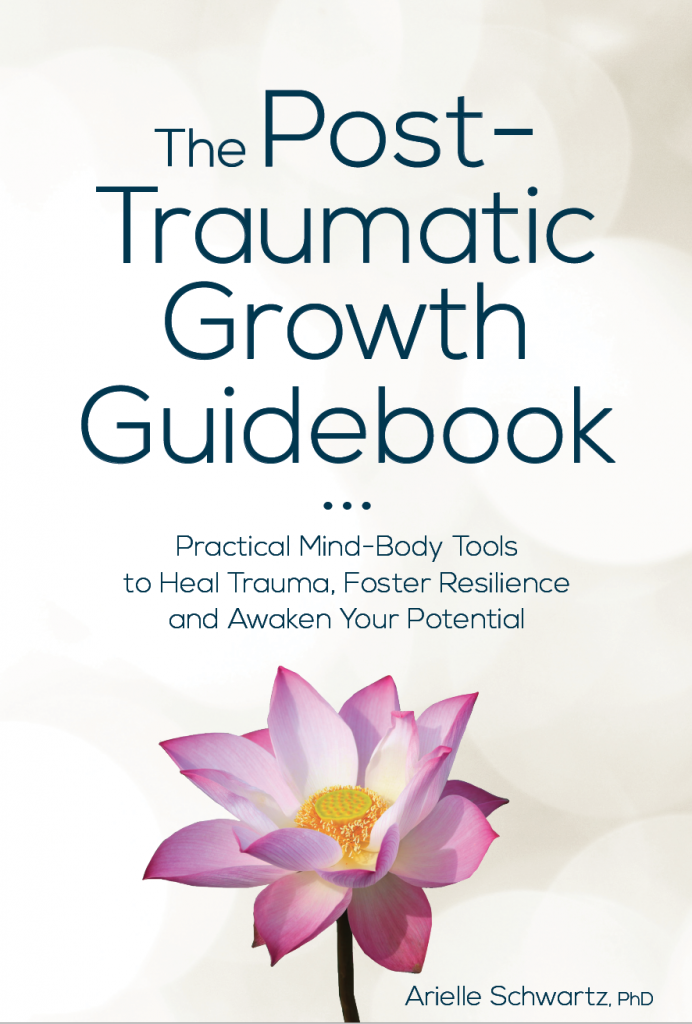
Within The Post Traumatic Growth Guidebook, you will find an invitation to see yourself as the hero or heroine of your own life journey. A hero’s journey involves walking into the darkness on a quest for wholeness. This interactive format calls for journaling and self-reflection, with practices that guide you beyond the pain of your past and help you discover a sense of meaning and purpose in your life. Successful navigation of a hero’s journey provides opportunities to discover that you are more powerful than you had previously realized. Click here to order the book on Amazon.
A Practical Guide to Complex PTSD
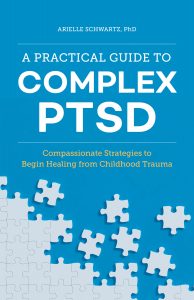
As a compliment to the Complex PTSD Workbook, A Practical Guide to Complex PTSD: Compassionate Strategies for Childhood Trauma, is meant to provide compassionate support for the process of healing from childhood trauma. You can think of it as a lantern that will illuminate the dark spaces and provide a sense of hope in moments of despair. The practical strategies you will learn in this book are taken from the most effective therapeutic interventions for trauma recovery. You will learn the skills to improve your physical and mental health by attending to the painful wounds from your past without feeling flooded with overwhelming emotion. My wish is to help you discover a new sense of freedom. The traumatic events of your past no longer need to interfere with your ability to live a meaningful and satisfying life. Click here to Order on Amazon.
Bestselling Workbook on C-PTSD

In The Complex PTSD Workbook, you’ll learn all about Complex PTSD Recovery and gain valuable insight into the types of symptoms associated with unresolved childhood trauma, while applying a strength-based perspective to integrate positive beliefs and behaviors. This is a great add-on with the Post Traumatic Growth Guidebook…Click here to order.
Heal and Learn with Dr. Arielle Schwartz
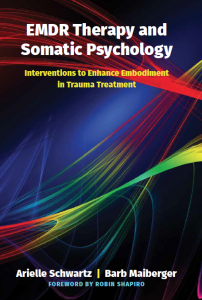
For therapists,The EMDR Therapy and Somatic Psychology book, teaches you how to integrate two of the best known trauma recovery modalities into your practice. Click to order it here and increase your toolbox for healing using this integrative and effective approach to healing.
About Dr. Arielle Schwartz
Dr. Arielle Schwartz is a licensed clinical psychologist, wife, and mother in Boulder, CO. She offers trainings for therapists, maintains a private practice, and has passions for the outdoors, yoga, and writing. She is the developer of Resilience-Informed Therapy which applies research on trauma recovery to form a strength-based, trauma treatment model that includes Eye Movement Desensitization and Reprocessing (EMDR), somatic (body-centered) psychology and time-tested relational psychotherapy. Like Dr. Arielle Schwartz on Facebook,follow her on Linkedin and sign up for email updates to stay up to date with all her posts. Dr. Schwartz is the author of three books:
- The Complex PTSD Workbook: A Mind-Body Approach to Regaining Emotional Control and Becoming Whole (Althea press, 2016)
- EMDR Therapy and Somatic Psychology: Interventions to Enhance Embodiment in Trauma Treatment (Norton, 2018).
- The Post-Traumatic Growth Guidebook: Practical Mind-Body Tools to Heal Trauma, Foster Resilience, and Awaken your Potential (Pesi Publications, 2020)

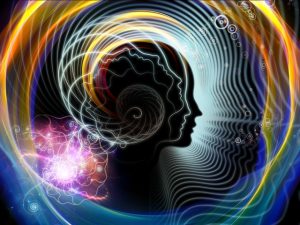
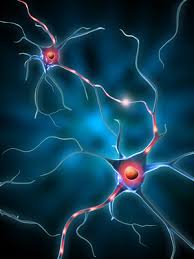



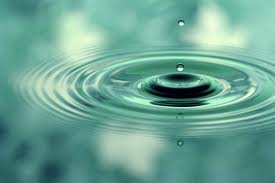

This is really helpful. I am convinced that the Vagus nerve is a major key in the mind/body connection – if it is the cause of a problem, it can also be the solution:)
Good article!
One thing I as an emergency responder experience, and I am today, is that when a call, even a simple call like last night’s simple fire, topped off with short sleep, activates my PTSD symptoms, the LAST thing I want to do is connect. Maybe after a good night’s sleep, this will change. Of course it will, everything is impermanent.
I do however, use humming, and the 4-7-8 breathing technique, and at times when I feel avoidant, sitting still with nature.
Great to hear from you, Lecky. I love connecting with others who have a passion for resilience and resilience practices. Nature, humming, 4-7-8. Excellent. I took a moment to check out your website and see you do TRE. Fantastic exercises to release trauma from the body. Whidbey Island is lucky to have you and Petra. Glad to know you are out there. Are you on Facebook? Connect with me there at https://www.facebook.com/drarielleschwartz
Dr. Arielle Schwartz
Thank you. We are getting more out there. I travel to Georgia to teach emergency responders in FEMA region IV next month. Five more next year. Petra is moving towards women who gave traumatic births, as that was her experience.
I am on Facebook, https://www.facebook.com/RobertLeckeyHarrison. Also LinkedIn, https://www.linkedin.com/profile/preview?vpa=pub&locale=en_US.
Please sign me up for email updates of new posts
Got you on the list! Great that you’ll stay up to date on what I’m posting.
Dr. Arielle Schwartz
I would like to try these techniques and everyone does a great job of explaining how to do them however no one talks about duration. Should humming be done for 1-3 minutes or 15, 30 or how long?
Should the breathing exercises be done in 15 minute durations three or four times a day?
I’m really looking for a bit of guidance. Thank you for any info you can share.
Robyn,
Great questions! I think the answer is very personal. Experiment for yourself. How long do you need to practice any of the exercises until you feel a shift internally? Listen to your body and your intuition. Personally I find that one longer (45-60 min) mindfulness or yoga practice each day accompanied by mini breath awareness and movement breaks works for me. I’d love to hear what you learn as you explore what works for you.
With Care,
Dr. Arielle
Thank you.
Sandy,
You’re welcome.
So glad you found this helpful.
Dr. Arielle Schwartz
A really helpful article. I am only recently learning about the role off the vagus nerve in chronic pain conditions and ptsd as well as the polyvagal response. I appreciate your outline of the vagal nerve stimulation exercises. Some I have been practicing for years and others I am learning the value of.
Theresa. ( New Zealand ).
Theresa,
I am so glad that you found this article helpful. It is always great to get feedback.
Warmly,
Dr. Arielle
I teach how to access the parasympathetic response in my yoga classes and now know the root of the response!! Fabulous information. Thank you for posting!
Rebecca,
Yes, applying this for yoga classes is so helpful. I am glad you found this information helpful.
Dr. Arielle Schwartz
Thank you for this information.
I am so glad you found this helpful.
Dr. Arielle Schwartz
Hi Arielle, did you know that there´s an app that can stimulate your vagus nerve? ORIC for iPhone turns your music into medicine. It´s amazing: http://www.ORIC.com
Think vegus nerve is at the root of my gerd and ibs.i have scoliosis and whiplash and broke my back as a child. Interested .